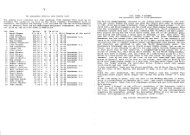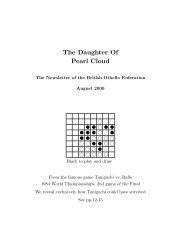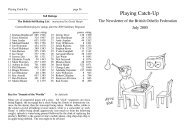5 4 3 2 1 a b c d 6 7 8 - British Othello Federation
5 4 3 2 1 a b c d 6 7 8 - British Othello Federation
5 4 3 2 1 a b c d 6 7 8 - British Othello Federation
Create successful ePaper yourself
Turn your PDF publications into a flip-book with our unique Google optimized e-Paper software.
It Ain't Over 'Til it's Over Page 6<br />
my choices at move 36 was highly depressing.<br />
Having decided that a5 did not work and that g3 really lost horribly to d7,<br />
I played 36d7. Of course, this flips the c6 disc, making Stoner traps a real<br />
threat for later. Michael played 37g3, as planned, and I replied 38h4 to keep<br />
him out of e1 for the moment.<br />
At move 39, where should Black play There is a real opportunity to gain<br />
access to e1 by playing h3 h2. Indeed, the sequence 39h3 40h2 41e1 42b1<br />
gives Black a very nice 43d8 and what appears to be a very good position.<br />
However, if then 44e8 45f8 46b8, how is Black to proceed He can play off<br />
pairs like a5 a7 and c8 g8, but then what For this reason, Black decided not<br />
to play this sequence, preferring instead to leave the North edge as a horrible<br />
White liability until near the end. This makes good sense, since on general<br />
grounds when Black is so clearly ahead there is no need for him to start<br />
cashing in the White edges.<br />
After 42b8<br />
So instead Black played to d8. After 40e8<br />
41f8 42b8, it is Black to play. What should he<br />
do Note that on each of the four edges White has<br />
a horrible structure -- but how should Black attack<br />
them<br />
One very obvious way to proceed rests on the<br />
fact that the pair of a5 a7 will give Black parity,<br />
thanks to the a8 corner region. Since White has<br />
no control at all, loss of parity will be fatal. So a<br />
Black move to a5 will have to be met by a White<br />
move other than a7 -- for example b1, for parity in<br />
the a1 corner region. But this is giving up a lot of<br />
discs. Before this, though, Black played 43h6. The point of this is that the<br />
obvious recapture of 44h7 dies quickly to 45h2 -- White's only real try is<br />
46g7, and then White does get the East edge but Black gets everything else<br />
(for example, with the simple 47h8 48h3 49g8).<br />
Given that 44h7 was no good, I played 44g2. This at least keeps parity.<br />
The problem with it is that, after 45a5, I cannot play 46a7, as explained above.<br />
So I have to play 46b1, and that is giving up a vast number of stable discs. In<br />
particular, I am not getting any wedge at e1 (as one might ordinarily hope that<br />
a move like g2 would lead to). So, after this 46b1, we had 47h1 48e1 49a1<br />
50b2. I was already mentally congratulating Michael on his win and feeling<br />
miserable that I'd lost the Final two years in a row.<br />
After 51h3, I sat and thought about my move. I knew I could play a 'feed'<br />
if I wanted, which was probably the right thing to do in terms of number of<br />
discs: 52b7 53a8 54a7 55c8 would give up a lot of discs, especially with the<br />
c8 move, but at least then I could play 56g8 and have a feed. The idea of the<br />
feed, a classic way for White to get the last move in a region of 4 where Black<br />
It Ain't Over 'Til it's Over Page 17<br />
How to Analyse your Games with Zebra by Geoff Hubbard<br />
INTRODUCTION<br />
WZebra (or just Zebra) is an <strong>Othello</strong> program for PCs running Windows.<br />
In this article I'll describe how you can use Zebra to analyse your own <strong>Othello</strong><br />
games easily in order to improve your play.<br />
After each tournament I analyse my games with Zebra. This allows me to<br />
see where I'm going right and where I'm going wrong in my games. It helps<br />
me find the 2 or 3 most important moves in the game easily without having to<br />
manually analyse every move of the game. This means that by spending only<br />
5-10 minutes reviewing each game I make sure that I keep improving.<br />
GETTING ZEBRA<br />
Get Zebra from the 'downloads' link on the BOF website or go to:<br />
http://www.radagast.se/othello/download.html You want the file wz424.exe<br />
Download and Run it to install WZebra.<br />
SETTING UP FOR ANALYSIS<br />
1) Open Zebra; 2) Select the 'Zebra Settings' Menu; 3) Choose 'Search<br />
depth'; 4) Select '16 Moves + last 20 Perfect'.<br />
A Note about Search Depth: If you have a faster computer or are<br />
prepared to wait longer choose a higher number. If you have a slower<br />
computer or just want faster results select a lower number. The higher the<br />
number you choose the more exact your results will be. Choosing 'Solving<br />
(exact)' might seem like a good idea, but it will take a very long time (millions<br />
of years). I find 16/20 a good compromise on my 5-year-old computer.<br />
5) Select the 'Options' Menu.<br />
Make sure the following options are ticked: a) View scores, b) Show<br />
principal variation, c) Display evaluations on board, d) Display a graph<br />
summarising analysis.<br />
It's not a problem if other options are also ticked, but these are the most<br />
useful ones we're going to need for now.<br />
ENTERING YOUR GAME<br />
Select the 'Game' menu and choose 'New practice session.' You should<br />
now see a board at the starting position with +0 showing in each square of<br />
Black's 4 valid moves.<br />
Play through the game from your transcript. On the right hand side there<br />
is a box which shows you the move number and co-ordinates of the moves so<br />
far.<br />
As you go it will show you on the board some analysis of all the valid<br />
moves. Positive numbers are good, negative ones are bad. The evaluation of








